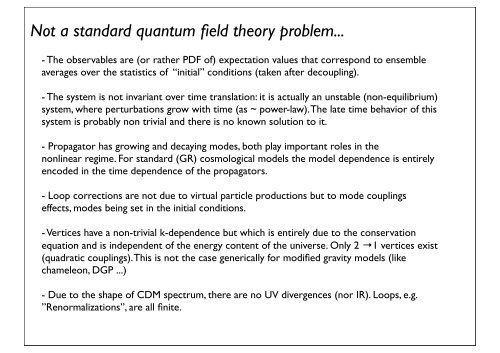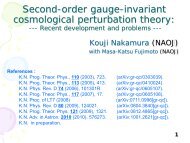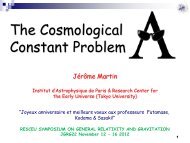The development of gravitational instabilities - RESCEU
The development of gravitational instabilities - RESCEU
The development of gravitational instabilities - RESCEU
You also want an ePaper? Increase the reach of your titles
YUMPU automatically turns print PDFs into web optimized ePapers that Google loves.
Not a standard quantum field theory problem...<br />
- <strong>The</strong> observables are (or rather PDF <strong>of</strong>) expectation values that correspond to ensemble<br />
averages over the statistics <strong>of</strong> “initial” conditions (taken after decoupling).<br />
- <strong>The</strong> system is not invariant over time translation: it is actually an unstable (non-equilibrium)<br />
system, where perturbations grow with time (as ~ power-law). <strong>The</strong> late time behavior <strong>of</strong> this<br />
system is probably non trivial and there is no known solution to it.<br />
- Propagator has growing and decaying modes, both play important roles in the<br />
nonlinear regime. For standard (GR) cosmological models the model dependence is entirely<br />
encoded in the time dependence <strong>of</strong> the propagators.<br />
- Loop corrections are not due to virtual particle productions but to mode couplings<br />
effects, modes being set in the initial conditions.<br />
- Vertices have a non-trivial k-dependence but which is entirely due to the conservation<br />
equation and is independent <strong>of</strong> the energy content <strong>of</strong> the universe. Only 2 →1 vertices exist<br />
(quadratic couplings). This is not the case generically for modified gravity models (like<br />
chameleon, DGP ...)<br />
- Due to the shape <strong>of</strong> CDM spectrum, there are no UV divergences (nor IR). Loops, e.g.<br />
”Renormalizations”, are all finite.




![2011年度 [PDF: 12.1 MB] - RESCEU - æ±äº¬å¤§å¦](https://img.yumpu.com/25708645/1/184x260/2011aa-pdf-121-mb-resceu-aeaaa.jpg?quality=85)





